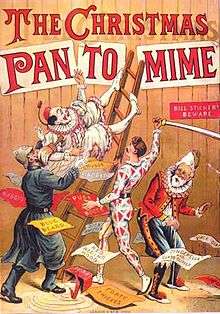Culture of England
| Culture of England |
|---|
 |
| History |
| People |
| Languages |
|
Traditions |
|
Mythology and folklore
|
| Cuisine |
| Religion |
| Art |
| Literature |
|
Music and performing arts
|
|
Media
|
|
Monuments |
|
The culture of England is defined by the idiosyncratic cultural norms of England and the English people.
Owing to England's influential position within the United Kingdom it can sometimes be difficult to differentiate English culture from the culture of the United Kingdom as a whole.[1] However, since Anglo-Saxon times, England has had its own unique culture, apart from Welsh, Scottish or Northern Irish culture.
Humour, tradition and good manners are characteristics commonly associated with being English.[2]
Architecture and gardens
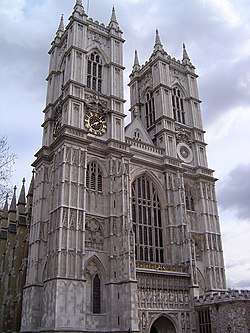
English architecture begins with the architecture of the Anglo-Saxons. At least fifty surviving English churches are of Anglo-Saxon origin, although in some cases the Anglo-Saxon part is small and much-altered. All except one timber church are built of stone or brick, and in some cases show evidence of reused Roman work. The architectural character of Anglo-Saxon ecclesiastical buildings ranges from Coptic-influenced architecture in the early period, through Early Christian basilica influenced architecture, to (in the later Anglo-Saxon period) an architecture characterized by pilaster-strips, blank arcading, baluster shafts and triangular-headed openings. Almost no secular work remains above ground.
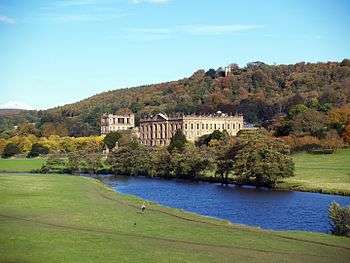
Following the Norman Conquest Romanesque architecture (known here as Norman architecture) superseded Anglo-Saxon architecture; later there was a period of transition into English Gothic architecture (of which there are three periods, Early English, Decorated, and Perpendicular). In early modern times there was an influence from Renaissance architecture until by the 18th century Gothic forms of architecture had been abandoned and various classical styles were adopted. During the Victorian period Neo-Gothic architecture was preferred for many types of buildings but this did not continue into the 20th century.
Other buildings such as cathedrals and parish churches are associated with a sense of traditional Englishness, as is often the palatial 'stately home'. Many people are interested in the English country house and the rural lifestyle, evidenced by the number of visitors to properties managed by English Heritage and the National Trust.
Landscape gardening as developed by Capability Brown set an international trend for the English garden. Gardening, and visiting gardens, are regarded as typically English pursuits.
English seaside piers
.jpg)
Following the building of the world's first seaside pier in July 1814 in Ryde, Isle of Wight off the south coast of England, the pier became fashionable at seaside resorts in England and Wales during the Victorian era, peaking in the 1860s with 69 being built.[3][4] Providing a walkway out to sea, the seaside pier is regarded among the finest Victorian architecture, and is an iconic symbol of the British seaside holiday.[3][5] By 1914, more than 100 piers were located around the UK coast.[3] Today there are approximately 55 seaside piers in the UK.[6]
Art
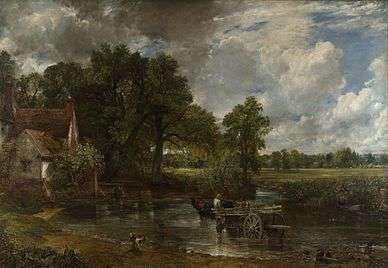
English art was dominated by imported artists throughout much of the Renaissance, but in the 18th century a native tradition became much admired. It is considered to be typified by landscape painting, such as the work of J.M.W. Turner and John Constable. Portraitists like Thomas Gainsborough and Joshua Reynolds are also significant.
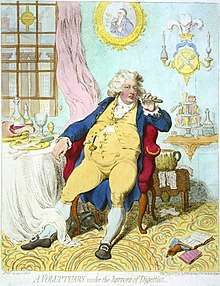
Pictorial satirist William Hogarth pioneered Western sequential art, and political illustrations in this style are often referred to as "Hogarthian".[7] Following the work of Hogarth, political cartoons developed in England in the latter part of the 18th century under the direction of James Gillray. Regarded as being one of the two most influential cartoonists (the other being Hogarth), Gillray has been referred to as the father of the political cartoon, with his satirical work calling the king (George III), prime ministers and generals to account.[8]
Cuisine
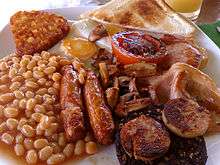
Since the early modern era, the food of England has historically been characterised by its simplicity of approach, honesty of flavour, and a reliance on the high quality of natural produce.[9] This has resulted in a traditional cuisine which tended to avoid strong flavours, such as garlic, and also complex sauces which were commonly associated with Roman Catholic Continental affiliations.[10] Traditional meals have ancient origins, such as bread and cheese, popular today as the ploughman's lunch, roasted and stewed meats, meat and game pies, and freshwater and saltwater fish. The 14th-century English cookbook, the Forme of Cury, contains recipes for these, and dates from the royal court of Richard II.
Modern English cuisine is difficult to differentiate from British cuisine as a whole. Moreover, the last half century has seen significant changes in eating habits and food retailing[11], growing interest in international cuisines, and the establishment of large chains of restaurants, fast-food outlets, bars, coffee shops and supermarkets. However, distinctively English dishes, artisanal production, home cooking and traditional establishments such as pubs, cafés, tearooms and independent retailers remain widespread.
The full English breakfast[12] typically comprises a choice from rashers of back bacon, fried or scrambled eggs, pork sausages,[13] black pudding, grilled tomatoes, mushrooms, hash browns, baked beans, fried bread and sometimes white pudding[14], usually served with toast and jam, marmalade or honey, and a cup of coffee or tea[15] Alternative breakfast dishes include boiled eggs with toast soldiers, kippers[16], smoked salmon and scrambled eggs, and bubble and squeak[17].
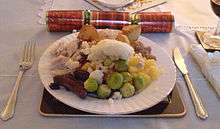
Roast beef is a food traditionally associated with the English; the link was made famous by Henry Fielding's patriotic ballad "The Roast Beef of Old England", and William Hogarth's painting of the same name. Indeed, since the 18th century the phrase "les rosbifs" has been a popular French nickname for the English.[18] Yorkshire puddings and horseradish sauce or English mustard are usually served with roast beef.[19] A Sunday roast of roasted meat and potatoes with vegetables remains popular[20] and lamb is eaten especially at Easter[21] An English Christmas dinner traditionally consists of turkey, which first appeared on the English Christmas dinner table in 1573, cranberry sauce, bread sauce, stuffing, gravy, pigs in blankets, roast potatoes, chestnuts, Brussels sprouts and other vegetables.[22]. It is sometimes accompanied by cooked gammon and usually followed by Christmas pudding, mince pies and Christmas cake.[23] Potted shrimps and slices of smoked salmon, such as London Cure,[24], are popular starters served with brown bread and a squeeze of lemon. Oysters are cultivated along the east coast of England, for example at Whitstable.
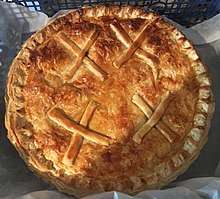

One English commentator wrote that “We have, throughout our history as a nation, had a weakness for meat in pastry which, while it is not unique, is a sort of hallmark of our taste.”[25] Pies appear in many common English idioms, such as "to eat humble pie", "as easy as pie", "pie in the sky" and "a slice of the pie". Typical English main courses[26] include steak and kidney pie, chicken and mushroom pie, bacon and egg pie, shepherd's pie (generally containing lamb), cottage pie (similar but made from beef), Lancashire hotpot, Beef Wellington, steak and kidney pudding, savoury bacon roll, fish and chips (often served with mushy peas)[27], fish pie, liver and bacon in onion gravy[28], sausage and mash, and toad in the hole.[29] The popularity of curry dishes, particularly Chicken Tikka Masala, represents the ubiquity of Indian cultural influence throughout England. English-style chutneys using orchard fruits originated from Indian chutneys. Balti is a form of curry invented in Birmingham in the 20th century.[30]
Butchers sell artisanal sausages of high-quality, which are sometimes made from the meat of pedigree breeds such as Gloucester Old Spot pigs. Cumberland and Lincolnshire sausages are popular regional varieties.[31] Potatoes are served roasted, boiled, baked, mashed, and as chips; popular varieties in England including King Edward, Jersey Royal, Charlotte and Maris Piper.[32] Dumplings made with flour, suet and seasonings are served with stews.[33] A wide range of fats and oils are used for cooking, including traditional lard.[34]
Savoury dishes and snacks include cauliflower cheese, Welsh rarebit, Cornish pasties, Scotch eggs, sausage rolls, pork pies[35] and - a staple of the traditional cafe - bacon sandwiches.[36] The sandwich was named after the Earl of Sandwich[37] and is very common as a lunchtime and picnic item with a wide range of fillings. Worcestershire sauce and brown sauce, along with ketchup, are distinctive English condiments.[38] Marmite is an acquired taste.
English desserts include Bramley apple pie, bread and butter pudding, fruit crumble, sticky toffee pudding, treacle tart, treacle sponge pudding (made with golden syrup), jam roly-poly, spotted dick, Bakewell tart, trifle, Eton mess, summer pudding and banoffee pie.[39] Hot puddings are often served with custard. Fruits grown in England include apples, pears, plums, cherries, damsons, blackberries, black currants, gooseberries, raspberries, strawberries (often served with cream) and rhubarb[40]. Ice creams are sometimes sold from ice cream vans which use distinctive chimes to attract customers[41]
Afternoon tea
Traditionally, High Tea would be had as a full evening meal, whereas Afternoon Tea was a lighter meal taken earlier in the afternoon only by some classes of society. A cream tea includes a pot of tea and scones served with jam and clotted cream from Devon or Cornwall[42], sometimes accompanied by dainty finger sandwiches, with fillings such as cucumber and smoked salmon[43], and cake.[44] Teas are typically served in tearooms and hotels.
English cakes include Victoria sponge, Madeira cake, fairy cakes, Battenberg cake, Eccles cake and Simnel cake (the latter being associated with Mothering Sunday and Easter),[45] Other items served for afternoon tea[46] include teacakes, crumpets and pikelets,[47] English muffins[48] and lardy cakes.[49] There are several types of fruited bun such as currant buns, Chelsea buns and hot cross buns (the latter marking Good Friday).[50] English Pancakes are popular on Shrove Tuesday.[51]
Cheese
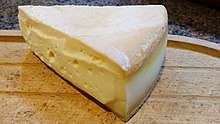
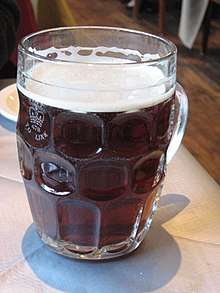
Different types of milk and dairy products are widely consumed. Although English cheesemaking was restricted by wartime rationing, there are now over 750 different cheeses[52] including traditional (generally hard) regional cheeses such as:
- Cheddar cheese
- Cheshire cheese
- Blue and White Stilton cheese
- Wensleydale cheese
- Lancashire cheese
- Double Gloucester cheese
- Red Leicester
- Shropshire Blue cheese
- Dorset Blue Vinney cheese
- Swaledale cheese
Recent decades have seen the production of semi-soft or soft cheeses, such as Stinking Bishop, Cornish Yarg, Rollright cheese, Wigmore cheese, Oxford Blue and Brie.
Drinks

Tea and beer are typical and rather iconic drinks in England. A cup of tea is often accompanied with a biscuit or piece of cake.[53] Whilst tea drinking and tearooms have declined in number since the rise of global chains of coffee shops in the 1990s,[54] there has been renewed interest in cask ale since the 1970s: driven by the Campaign for Real Ale. More recently the term "craft beer" has been used to reflect global brewing trends.[55] Traditional styles of English ale[56] include several types of pale ale (particularly bitter, IPA and golden ale), darker porter and stout, lightly-hopped mild ale (which fell out of fashion in the 1960s[57]), stronger old ale (popular as a winter warmer), brown ale and barley wine. Bitters (ordinary, best and extra special depending on strength) balance malt and hop flavours, IPA is extra-hopped, and golden ale was developed at the end of the 1980s to compete against lagers, which grew in popularity in England in the late 20th century. Cider is produced in the West Country.[58].
Magna Carta stated there should be a single measure for ale.[59] Beer and cider, often served draught in pubs, are served by the pint or half-pint, either in a straight glass or a dimpled glass tankard (known as a jug).[60] They are often drunk with snack food such as crisps, dry roasted or salted peanuts, and pork scratchings or a meal (perhaps advertised alliteratively as a "pie and a pint"). Beer is used metaphorically to refer to pleasure, as in cakes and ale and beer and skittles. Ginger beer is a popular, usually non-alcoholic, drink. Gin has been popular in England since the late 17th century and is often served with tonic water.[61] Pimm's No. 1 Cup, a gin-based drink containing a mixture of herbs and liquors, is popular for making punch for summer social events.[62] More recently, the south of England has seen the reintroduction of vineyards making English wine.[63]
Folklore
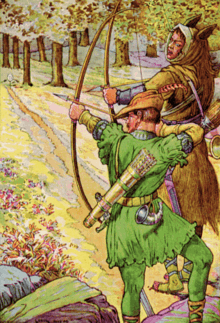
English folklore developed over many centuries. Some of the characters and stories are present all over England, but most belong to specific regions. Common folkloric beings include pixies, giants, elves, bogeymen, trolls, goblins and dwarves. While many legends and folk-customs are thought to be ancient, for instance the tales featuring Offa of Angel and Wayland the Smith,[64] others date from after the Norman conquest of England; Robin Hood and his Merry Men of Sherwood and their battles with the Sheriff of Nottingham being, perhaps, the best known.[65]
During the High Middle Ages tales originated from Brythonic traditions, notably the Arthurian legend.[66][67] Deriving from Welsh sources; King Arthur, Excalibur and Merlin, while the Jersey poet Wace introduced the Knights of the Round Table. These stories are most centrally brought together within Geoffrey of Monmouth's Historia Regum Britanniae. Another early figure from British tradition, King Cole, may have been based on a real figure from Sub-Roman Britain. Many of the tales and pseudo-histories make up part of the wider Matter of Britain, a collection of shared British folklore.
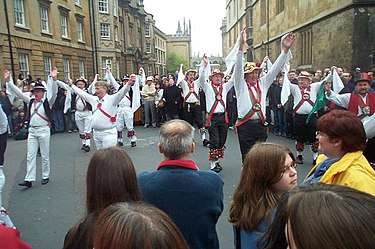
Some folk figures are based on semi or actual historical people whose story has been passed down centuries; Lady Godiva for instance was said to have ridden naked on horseback through Coventry, Hereward the Wake was a heroic English figure resisting the Norman invasion, Herne the Hunter is an equestrian ghost associated with Windsor Forest and Great Park (whose tale bears the common European folkloric motif of the Wild Hunt) and Mother Shipton is the archetypal witch.[68] The chivalrous bandit, such as Dick Turpin, is a recurring character. There are various national and regional folk activities, participated in to this day, such as Morris dancing, Maypole dancing, Rapper sword in the North East, Long Sword dance in Yorkshire, Mummers Plays, bottle-kicking in Leicestershire, and cheese-rolling at Cooper's Hill.[69] There is no official national costume, but a few are well established such as the Pearly Kings and Queens associated with cockneys, the Royal Guard, the Morris costume and Beefeaters.[70] The utopian vision of a traditional England is sometimes referred to as Merry England.

Published in 1724, A General History of the Pyrates by Captain Charles Johnson provided the standard account of the lives of many pirates in the Golden Age of Piracy.[71] Many famous English pirates from the Golden Age hailed from the West Country in the south west coast of England—the stereotypical West Country "pirate accent" was popularised by West Country native Robert Newton's portrayal of Long John Silver in film.[72][73] The concept of "walking the plank" was popularised by J. M. Barrie's novel, Peter Pan, where Captain Hook's pirates helped define the archetype.[74] Davy Jones' Locker where sailors or ship's remains are consigned to the bottom of the sea is first recorded by Daniel Defoe in 1726.[75] Johnson's 1724 book gave a mythical status to famous English pirates such as Blackbeard and Calico Jack. Jack is known for his Jolly Roger flag design, a skull with crossed swords.[76]
The Gremlin is part of Royal Air force folklore dating from the 1920s, with gremlin being RAF slang for a mischievous creature that sabotages aircraft, meddling in the plane's equipment.[77] Legendary figures from 19th century London whose tales have been romanticised include Sweeney Todd, the murderous barber of Fleet Street, and serial killer Jack the Ripper. On 5 November, people in England make bonfires, set off fireworks and eat toffee apples in commemoration of the foiling of Guy Fawkes' Gunpowder Plot, which became an annual event after The Thanksgiving Act of 1606 was passed.[78] Guy Fawkes mask is an emblem for anti-establishment protest groups.[79]
Language
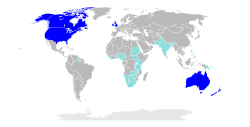
English people traditionally speak the English language, a member of the West Germanic language family. The modern English language is now known as the potential Norman speakings but has now evolved from Middle English (the form of language in use by the English people from the 12th to the 15th century); Middle English was influenced lexically by Norman-French, Old French and Latin. In the Middle English period Latin was the language of administration and the nobility spoke Norman French. Middle English was itself derived from the Old English of the Anglo-Saxon period; in the Northern and Eastern parts of England the language of Danish settlers had influenced the language, a fact still evident in Northern English dialects. During its history Modern English has drawn extensively from the vocabulary other languages. e.g. French, Latin, Greek, Dutch and to a lesser extent from many others.
There were once many different dialects of modern English in England - which were recorded in projects such as the English Dialect Dictionary (late 19th century) and the Survey of English Dialects (mid 20th century), but many of these have passed out of common usage as Standard English has become more widespread through education, the media and socio-economic pressures.[80]
Cornish, a Celtic language, is one of three existing Brythonic languages; its usage has been revived in Cornwall. Historically, another Brythonic Celtic language, Cumbric, was spoken in Cumbria in North West England, but it died out in the 11th century although traces of it can still be found in the Cumbrian dialect. Early Modern English began in the late 15th century with the introduction of the printing press to London and the Great Vowel Shift. Through the worldwide influence of the British Empire, English spread around the world from the 17th to mid-20th centuries. Through newspapers, books, the telegraph, the telephone, phonograph records, radio, satellite television, broadcasters (such as the BBC) and the Internet, as well as the post WWII emergence of the United States as a global superpower, Modern English has become the international language of business, science, communication, sports, aviation, and diplomacy.
Surnames
| Rank | Surname | Origin | Percentage[81] |
|---|---|---|---|
| 1 | Smith | England | 1.44 |
| 2 | Jones | England and Wales | 0.75 |
| 3 | Taylor | England and Scotland | 0.59 |
| 4 | Brown | Scotland | 0.56 |
| 5 | Williams | England and Wales | 0.39 |
| 6 | Wilson | England and Scotland | 0.39 |
| 7 | Johnson | England | 0.37 |
| 8 | Davis | Wales | 0.34 |
| 9 | Robinson | England | 0.32 |
| 10 | Wright | England | 0.32 |
| 11 | Thompson | England | 0.31 |
| 12 | Evans | Wales | 0.30 |
| 13 | Walker | England | 0.30 |
| 14 | White | England | 0.30 |
| 15 | Roberts | England | 0.28 |
| 16 | Green | England | 0.28 |
| 17 | Hall | England | 0.28 |
| 18 | Wood | England and Scotland | 0.27 |
| 19 | Jackson | England and Scotland | 0.27 |
| 20 | Clarke | England | 0.26 |
Law
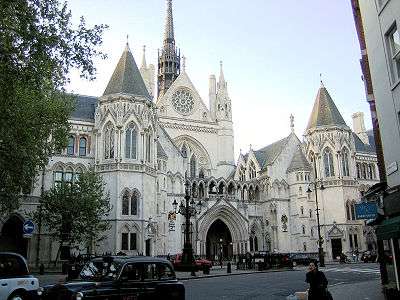
English law is the legal system of England and Wales.[82] Due to the British Empire, it has been exported across the world: it is the basis of common law jurisprudence.[83] The 18th century English jurist, judge and politician Sir William Blackstone is best known for his seminal work, Commentaries on the Laws of England, containing his formulation: "It is better that ten guilty persons escape than that one innocent suffer", a principle that government and the courts must err on the side of innocence, which has remained constant.[84] Sir William Garrow ushered in the adversarial court system in common law. He coined the phrase "presumed innocent until proven guilty", insisting that defendants' accusers and their evidence be thoroughly tested in court.[85]
Major constitutional documents include: Magna Carta (foundation of the "great writ" Habeas corpus — safeguarding individual freedom against arbitrary state action), the Bill of Rights 1689 (one provision granting freedom of speech in Parliament), Petition of Right, Habeas Corpus Act 1679 and Parliament Acts 1911 and 1949. The jurist Albert Venn Dicey wrote that the British Habeas Corpus Acts "declare no principle and define no rights, but they are for practical purposes worth a hundred constitutional articles guaranteeing individual liberty".[86] A strong advocate of the "unwritten constitution", Dicey stated English rights were embedded in English common law, and "the institutions and manners of the nation".[87]
Literature

English literature begins with Anglo-Saxon literature, which was written in Old English and produced such heroic epic works as Beowulf and the fragmentary The Battle of Maldon, the sombre and introspective The Seafarer and The Wanderer and the pious Dream of the Rood and The Order of the World. For many years, Latin and French were the preferred literary languages of England, but in the medieval period there was a flourishing of literature in Middle English; Geoffrey Chaucer is the most famous writer of this period. The Elizabethan era is sometimes described as the golden age of English literature, as numerous great poets were writing in English, and the Elizabethan theatre produced William Shakespeare, often considered the English national poet.
Due to the expansion of English into a world language during the British Empire, literature is now written in English across the world. Writers often associated with England or for expressing Englishness include Shakespeare (who produced two tetralogies of history plays about the English kings), Jane Austen, Arnold Bennett, and Rupert Brooke (whose poem "Grantchester" is often considered quintessentially English). Other writers are associated with specific regions of England; these include Charles Dickens (London), Thomas Hardy (Wessex), A. E. Housman (Shropshire), and the Lake Poets (the Lake District).
In the lighter vein, Agatha Christie's mystery novels are outsold only by Shakespeare and The Bible. Described as "perhaps the 20th century's best chronicler of English culture", the non-fiction works of George Orwell include The Road to Wigan Pier (1937), documenting his experience of working class life in the north of England.[88] Orwell's eleven rules for making tea appear in his essay "A Nice Cup of Tea", which was published in the London Evening Standard on 12 January 1946.[89]
In 2003 the BBC carried out a UK survey entitled The Big Read in order to find the "nation's best-loved novel" of all time, with works by English novelists J. R. R. Tolkien, Jane Austen, Philip Pullman, Douglas Adams and J. K. Rowling making up the top five on the list.[90]
Music

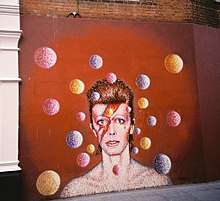
England has a long and rich musical history. The United Kingdom has, like most European countries, undergone a roots revival in the last half of the 20th century. English music has been an instrumental and leading part of this phenomenon, which peaked at the end of the 1960s and into the 1970s.
The achievements of the Anglican choral tradition following on from 16th-century composers such as Thomas Tallis, John Taverner and William Byrd have tended to overshadow instrumental composition. The semi-operatic innovations of Henry Purcell did not lead to a native operatic tradition, but George Frideric Handel found important royal patrons and enthusiastic public support in England. One of Handel's four Coronation Anthems, Zadok the Priest (1727), composed for the coronation of George II, has been performed at every subsequent British coronation, traditionally during the sovereign's anointing. The rapturous receptions afforded by audiences to visiting musical celebrities such as Haydn often contrasted with the lack of recognition for home-grown talent. However, the emergence of figures such as Edward Elgar and Arthur Sullivan in the 19th century showed a new vitality in English music. In the 20th century, Benjamin Britten and Michael Tippett emerged as internationally recognised opera composers, and Ralph Vaughan Williams and others collected English folk tunes and adapted them to the concert hall. Cecil Sharp was a leading figure in the English folk revival. The Proms, an annual summer season of daily classical music concerts, is a significant event in British musical life.[92] The Last Night of the Proms features patriotic music.
Finally, a new trend emerged from Liverpool in 1962. The Beatles became the most popular musicians of their time, and in the composing duo of John Lennon and Paul McCartney, popularized the concept of the self-contained music act. Before the Beatles, very few popular singers composed the tunes they performed. The "Fab Four" opened the doors for other acts from England such as The Rolling Stones, Led Zeppelin, Pink Floyd, Cream, The Kinks, The Who, Eric Clapton, David Bowie, Queen, Elton John, The Hollies, Black Sabbath, Deep Purple, Genesis, Dire Straits, Iron Maiden, The Police to the globe.
The Sex Pistols and The Clash were pioneers of punk rock. Some of England's leading contemporary artists include George Michael, Sting, Seal, Rod Stewart, The Smiths, The Stone Roses, Oasis, Blur, Radiohead, The Cure, Depeche Mode, Coldplay, Def Leppard, Muse, Arctic Monkeys, Amy Winehouse, Adele and Ed Sheeran.
Cinema
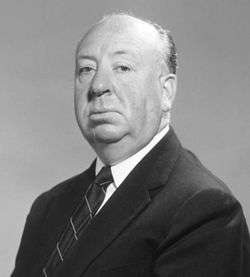
England (and the UK as a whole) has had a considerable influence on the history of the cinema, producing some of the greatest actors, directors and motion pictures of all time, including Alfred Hitchcock, Charlie Chaplin, David Lean, Laurence Olivier, Vivien Leigh, John Gielgud, Peter Sellers, Julie Andrews, Michael Caine, Gary Oldman, Helen Mirren, Kate Winslet and Daniel Day-Lewis. Hitchcock and Lean are among the most critically acclaimed of all-time.[95] Hitchcock's first thriller, The Lodger: A Story of the London Fog (1926), helped shape the thriller genre in film, while his 1929 film, Blackmail, is often regarded as the first British sound feature film.[96]
Major film studios in England include Pinewood, Elstree and Shepperton. Some of the most commercially successful films of all time have been produced in England, including two of the highest-grossing film franchises (Harry Potter and James Bond).[97] Ealing Studios in London has a claim to being the oldest continuously working film studio in the world.[98] Famous for recording many motion picture film scores, the London Symphony Orchestra first performed film music in 1935.[99]
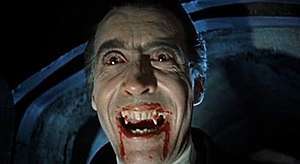
The BFI Top 100 British films includes Monty Python's Life of Brian (1979), a film regularly voted the funniest of all time by the UK public.[100] English producers are also active in international co-productions and English actors, directors and crew feature regularly in Hollywood films. Ridley Scott was among a group of English filmmakers, including Tony Scott, Alan Parker, Hugh Hudson and Adrian Lyne, who emerged from making 1970s UK television commercials.[101] The UK film council ranked David Yates, Christopher Nolan, Mike Newell, Ridley Scott and Paul Greengrass the five most commercially successful English directors since 2001.[102] Other contemporary directors from England include Sam Mendes, Guy Ritchie and Steve McQueen. Current actors include Tom Hardy, Daniel Craig, Benedict Cumberbatch and Emma Watson. Acclaimed for his motion capture work, Andy Serkis opened The Imaginarium Studios in London in 2011.[103] The visual effects company Framestore in London has produced some of the most critically acclaimed special effects in modern film.[104] Many successful Hollywood films have been based on English people, stories or events. The 'English Cycle' of Disney animated films include Alice in Wonderland, The Jungle Book, Robin Hood and Winnie the Pooh.[105]
Performing arts
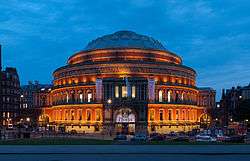
Large outdoor music festivals in the summer and autumn are popular, such as Glastonbury, V Festival, Reading and Leeds Festivals. England was at the forefront of the illegal, free rave movement from the late 1980s, which led to pan-European culture of teknivals mirrored on the UK free festival movement and associated travelling lifestyle.[106] The most prominent opera house in England is the Royal Opera House at Covent Garden.[107] The Proms, a season of orchestral classical music concerts held at the Royal Albert Hall, is a major cultural event held annually.[107] The Royal Ballet is one of the world's foremost classical ballet companies, its reputation built on two prominent figures of 20th century dance, prima ballerina Margot Fonteyn and choreographer Frederick Ashton.
A staple of British seaside culture, the quarrelsome couple Punch and Judy made their first recorded appearance in Covent Garden, London in 1662.[108] The various episodes of Punch and Judy are performed in the spirit of outrageous comedy — often provoking shocked laughter — and are dominated by the anarchic clowning of Mr. Punch.[109] Regarded as British cultural icons, they appeared at a significant period in British history, with Glyn Edwards stating: "[Pulcinella] went down particularly well with Restoration British audiences, fun-starved after years of Puritanism. We soon changed Punch's name, transformed him from a marionette to a hand puppet, and he became, really, a spirit of Britain - a subversive maverick who defies authority, a kind of puppet equivalent to our political cartoons."[108]
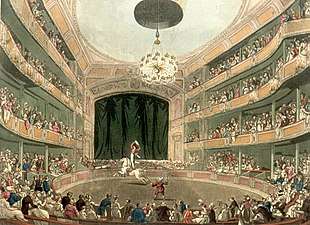
The circus is a traditional form of entertainment in the UK. Chipperfield's Circus dates back more than 300 years in Britain, making it one of the oldest family circus dynasties.[111] Philip Astley is regarded as the father of the modern circus.[110] Following his invention of the circus ring in 1768, Astley's Amphitheatre opened in London in 1773.[110][112] As an equestrian master Astley had a skill for trick horse-riding, and when he added tumblers, tightrope-walkers, jugglers, performing dogs, and a clown to fill time between his own demonstrations – the modern circus was born.[113][114] The Hughes Royal Circus was popular in London in the 1780s. Pablo Fanque's Circus Royal, among the most popular circuses of Victorian England, showcased William Kite, which inspired John Lennon to write "Being for the Benefit of Mr. Kite!" on The Beatles' album Sgt. Pepper's Lonely Hearts Club Band. Joseph Grimaldi, the most celebrated of clowns from England is considered the father of modern clowning.[115]
Pantomime (often referred to as "panto") is a British musical comedy stage production, designed for family entertainment. It is performed in theatres throughout the UK during the Christmas and New Year season. The art originated in the 18th century with John Weaver, a dance master and choreographer at the Theatre Royal, Drury Lane in London.[116] In 19th century England it acquired its present form, which includes songs, slapstick comedy and dancing, employing gender-crossing actors, combining topical humour with a story loosely based on a well-known fairy tale.[116] It is a participatory form of theatre, in which the audience sing along with parts of the music and shout out phrases to the performers, such as "It's behind you".[117]
Music hall is a type of British theatrical entertainment popular from the early Victorian era to the mid 20th century. The precursor to variety shows of today, music hall involved a mixture of popular songs, comedy, speciality acts and variety entertainment. British performers who honed their skills at pantomime and music hall sketches include Charlie Chaplin, Stan Laurel, George Formby, Gracie Fields, Dan Leno, Gertrude Lawrence and Harry Champion.[118][119] British music hall comedian and theatre impresario Fred Karno developed a form of sketch comedy without dialogue in the 1890s, and Chaplin and Laurel were among the music hall comedians who worked for him.[120] A leading film producer stated; "Fred Karno is not only a genius, he is the man who originated slapstick comedy. We in Hollywood owe much to him."[121]
Philosophy
English philosophers include Francis Bacon, Sir Thomas More, John Locke, Thomas Hobbes, Thomas Paine, Jeremy Bentham, John Stuart Mill and Bertrand Russell.
Religion
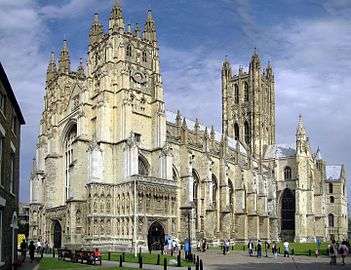
Christianity became the dominant religion in England in the 7th century. Polytheistic Indo-European religions, often referred to as paganism, were practised before Christianity took hold. The most notable of these religions were Celtic polytheism, Roman polytheism and Anglo-Saxon paganism, which was the religion of the early English people, or Anglo-Saxons, and which was in many ways very similar to the closely related Norse paganism practised by the Scandinavian peoples and that would later be introduced to England by the Danes.
Christianity was first established in Britain by the Roman Empire. According to legend, Christianity was introduced to Britain by Joseph of Arimathea, who came to Glastonbury. There is also a tradition ascribing this accomplishment to Lucius of Britain. Archaeological evidence for Christian communities begins to appear in the 3rd and 4th centuries. The Romano-British population after the withdrawal of the Roman legions remained mostly Christian. The Anglo-Saxon invaders and settlers who replaced them, founding the English nation, represented a stark return to pre-Christian religion for Britain. From the arrival of the Anglo-Saxons beginning in the 4th century until the arrival of the Augustinian Mission in 597 AD, England was entirely pagan, and the pre-Christian Germanic religion was practised openly in pockets throughout the country for many decades after this.
Christianity was reintroduced into England by missionaries from Scotland and from Continental Europe: the era of Augustine of Canterbury, the first Archbishop of Canterbury, and the Celtic Christian missionaries in the north (notably Aidan of Lindisfarne and Cuthbert who came from Scotland) began in 597 AD. The Synod of Whitby in 664 ultimately led to the Church of England being fully part of the Catholic Church. Early English Christian documents from this time include the 7th-century illuminated Lindisfarne Gospels and the historical accounts written by Bede. The Durham Gospels is a Gospel book produced at Lindisfarne.
In 1536, the Church of England split from Rome over the issue of the divorce (technically, the marriage annulment) of King Henry VIII from Catherine of Aragon. The split led to the emergence of a separate ecclesiastical authority. Later the influence of the Reformation resulted in the Church of England adopting its distinctive reformed Catholic position known as Anglicanism which maintains episcopacy while adopting a Lutheran theology. For more detail of this period see the following article: Timeline of the English Reformation.
Today, the Church of England is the established church in England. It regards itself as in continuity with the pre-Reformation state Catholic church (something the Roman Catholic Church does not accept) and has been a distinct Anglican church since the settlement under Elizabeth I of England (with some disruption during the 17th-century Commonwealth of England period). The British Monarch is formally Supreme Governor of the Church of England. Its spiritual leader is the Archbishop of Canterbury, who is regarded by convention as the head of the worldwide Anglican Communion. In practice the Church of England is governed by the General Synod of the Church of England, under the authority of Parliament. The Church of England's mission to spread the Gospel has seen the establishment of many churches in the Anglican Communion throughout the world particularly in the Commonwealth of Nations.
A strong tradition of Methodism developed from the 18th century onward. The Methodist revival was started in England by a group of men including John Wesley and his younger brother Charles Wesley as a movement within the Church of England; it developed as a separate denomination after John Wesley's death. Other non-conformist Protestant traditions were also established in England.
Saint George is recognised as the patron saint of England. Before Edward III, Edmund the Martyr was recognised as England's patron saint, and the flag of England consists of the Saint George's Cross. However, Saint Alban is venerated by some as England's first Christian martyr.
Change ringing is the traditional method of bell ringing in English churches, co-ordinated by the Central Council of Church Bell Ringers[122] and promoted by societies such as the Ancient Society of College Youths and the Society of Royal Cumberland Youths. Change ringing is central to The Nine Tailors by Dorothy L. Sayers, voted the best crime novel of the 1930s by the British Crime Writers' Association.[123]
Celebration of Christmas

In 17th-century England, the Puritans condemned the celebration of Christmas.[124] In contrast, the Anglican Church "pressed for a more elaborate observance of feasts, penitential seasons, and saints' days. The calendar reform became a major point of tension between the Anglicans and Puritans."[125] The Catholic Church also responded, promoting the festival in a more religiously oriented form. King Charles I of England directed his noblemen and gentry to return to their landed estates in midwinter to keep up their old-style Christmas generosity. Following the Parliamentarian victory over Charles I during the English Civil War, Puritan rulers banned Christmas in 1647.[126]
Protests followed as pro-Christmas rioting broke out in several cities and for weeks Canterbury was controlled by the rioters, who decorated doorways with holly and shouted royalist slogans.[124] The book, The Vindication of Christmas (London, 1652), argued against the Puritans, and makes note of Old English Christmas traditions, dinner, roast apples on the fire, card playing, dances with "plow-boys" and "maidservants", old Father Christmas and carol singing.[127] The Restoration of King Charles II in 1660 ended the ban. Following the Restoration, Poor Robin's Almanack contained the lines: "Now thanks to God for Charles return, / Whose absence made old Christmas mourn. / For then we scarcely did it know, / Whether it Christmas were or no."[128]
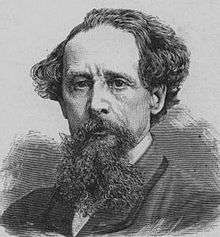
In the early 19th century, writers imagined Tudor Christmas as a time of heartfelt celebration. In 1843, Charles Dickens wrote the novel A Christmas Carol that helped revive the "spirit" of Christmas and seasonal merriment.[129][130] Dickens sought to construct Christmas as a family-centred festival of generosity, in contrast to the community-based and church-centred observations, the observance of which had dwindled during the late 18th century and early 19th century.[131] Dickens influenced many aspects of Christmas that are celebrated today in Western culture, such as family gatherings, seasonal food and drink, dancing, games, and a festive generosity of spirit.[132] A prominent phrase from the tale, "Merry Christmas", was popularized following the appearance of the story.[133] The term Scrooge became a synonym for miser, with "Bah! Humbug!" dismissive of the festive spirit.[130]
The revival of the Christmas Carol began with William Sandys's Christmas Carols Ancient and Modern (1833), with the first appearance in print of "The First Noel", "I Saw Three Ships", "Hark the Herald Angels Sing" and "God Rest Ye Merry, Gentlemen". In 1843 the first commercial Christmas card was produced by Henry Cole leading to the exchange of festive greeting cards among the public.[134]
Historical markers: blue plaques
.jpg)
A blue plaque, the oldest historical marker scheme in the world, is a permanent sign installed in a public place in the UK to commemorate a link between that location and a famous person or event.[135] The scheme was the brainchild of politician William Ewart in 1863 and was initiated in 1866.[135] It was formally established by the Society of Arts in 1867, and since 1986 has been run by English Heritage.[135]
The first plaque was unveiled in 1867 to commemorate Lord Byron at his birthplace, 24 Holles Street, Cavendish Square, London. Examples that commemorate events include John Logie Baird's first demonstration of the television at 22 Frith Street, Westminster, W1, London, and the first sub 4-minute mile run by Roger Bannister on 6 May 1954 at Oxford University's Iffley Road Track.
Science

England was a leading centre of the Scientific Revolution since the 17th century.[138] The English have played a significant role in the development of science and engineering. Prominent individuals have included Roger Bacon, Francis Bacon, William Harvey, Robert Hooke, Isaac Newton, Edward Jenner, Henry Cavendish, Isambard Kingdom Brunel, Francis Crick, Charles Babbage, Abraham Darby, Michael Faraday, Charles Darwin, James Chadwick, Joseph Swan, Barnes Wallis, Alan Turing, Frank Whittle, Tim Berners-Lee and Stephen Hawking. It is home to the Royal Institution, the Royal Society, the Greenwich Observatory and its associated meridian.
Industrial Revolution
The Industrial Revolution began in England due to the social, economic and political changes implemented in the previous centuries. Whereas absolute monarchy stayed the normal form of power execution through most parts of Europe, institutions ensured property rights and political safety to British people after the Glorious Revolution of 1688. Aided by these legal and cultural foundations, an entrepreneurial spirit and consumer revolution drove industrialisation in Britain.[139] Geographical and natural resource advantages of Great Britain also contributed, with the country's extensive coast lines and many navigable rivers in an age where water was the easiest means of transportation. Britain also had high quality coal. According to British historian Jeremy Black, "an unprecedented explosion of new ideas, and new technological inventions, transformed our use of energy, creating an increasingly industrial and urbanised country. Roads, railways and canals were built. Great cities appeared. Scores of factories and mills sprang up. Our landscape would never be the same again. It was a revolution that transformed not only the country, but the world itself."[140]
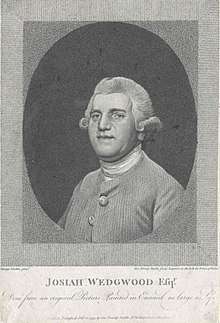
The 18th century entrepreneur Josiah Wedgwood is credited with the industrialisation of the manufacture of pottery. Meeting the demands of the consumer revolution and growth in wealth of the middle classes in Britain, Wedgwood created goods such as tableware, which was starting to become a common feature on dining tables.[140] Credited as the inventor of modern marketing, Wedgwood pioneered direct mail, money back guarantees, travelling salesmen, carrying pattern boxes for display, self-service, free delivery, buy one get one free, and illustrated catalogues.[141] Described as "natural capitalists" by the BBC, dynasties of Quakers were successful in business matters which contributed the Industrial Revolution. This included ironmaking by Abraham Darby I and his family; banking, including Lloyds Banking Group (founded by Sampson Lloyd),[142] Barclays PLC,[142] Backhouse's Bank and Gurney's Bank; life assurance (Friends Provident); pharmaceuticals (Allen & Hanburys[142]); the big three British chocolate companies Cadbury,[142] Fry's[142] and Rowntree[142]); biscuit manufacturing (Huntley & Palmers[142]); match manufacture (Bryant and May) and shoe manufacturing (Clarks). With his role in the marketing and manufacturing of James Watt's steam engine, and invention of modern coinage, Matthew Boulton is regarded as one of the most influential entrepreneurs in history.[143]
Other important English engineers and inventors in the Industrial Revolution include; George Stephenson, Richard Arkwright, Henry Maudslay and Isambard Kingdom Brunel. England has the oldest railway networks in the world, with the Stockton and Darlington Railway, opened in 1825, the first public railway to use steam locomotives.[144] Opened in 1863, London Underground is the world's first underground railway.[145] Known as the "Father of Railways", Stephenson's rail gauge of 4 feet 8 1⁄2 inches (1,435 mm) is the standard gauge for most of the world's railways. Henry Maudslay's most influential invention was the screw-cutting lathe, a machine which created uniformity in screws and allowed for the application of interchangeable parts (a prerequisite for mass production): it was a revolutionary development necessary for the Industrial Revolution.[146][147] Brunel created the Great Western Railway, as well as famous steamships including the SS Great Britain, the first propeller-driven ocean-going iron ship, and SS Great Eastern which laid the first lasting transatlantic telegraph cable.[148]
Sport and leisure

There are many sports which have been codified by the English, and then spread worldwide, including badminton, cricket, croquet, football, field hockey, lawn tennis, rugby league, rugby union, table tennis and thoroughbred horse racing. In the late 18th century, the English game of rounders was transported to the American Colonies, where it evolved into baseball. Association football, cricket, rugby union and rugby league are considered to be the national sports of England.
The rules of football were first drafted in 1863 by Ebenezer Cobb Morley, and England has the oldest football clubs in the world.[149] Recognised by FIFA as the birthplace of club football, Sheffield F.C., founded in 1857, is the world's oldest football club.[150] The first ever international football match was between England and Scotland in 1872.[151] Referred to by the sport's governing body FIFA as the "home of football", England hosted the 1966 FIFA World Cup, and won the tournament.[152] With a 32.3 million viewing audience, the 1966 final is the most watched television event ever in the United Kingdom.[153] The English Barclays Premier League is the most-watched football league in the world.[154] Its biggest clubs include Manchester United, Liverpool, Arsenal, Chelsea, Tottenham Hotspur and Manchester City. In 2016, Leicester City, who were 5,000-1 outsiders at the start of the season, became champions.[155] By some measures it was the greatest sporting upset ever: multiple bookmakers had never paid out at such long odds for any sport.[155] As is the case throughout the UK, football in England is renowned for the intense rivalries between clubs and the passion of the supporters, which includes a tradition of football chants, such as, "You're Not Singing Any More" (or its variant "We Can See You Sneaking Out!"), sung by jubilant fans towards the opposition fans who have gone silent (or left early).[156][157]
The modern game of tennis originated in Birmingham, England, in the 1860s,[159] and after its creation, tennis spread throughout the upper-class English-speaking population, before spreading around the world.[160] Major Walter Clopton Wingfield is credited as being a pioneer of the game.[161] The world's oldest tennis tournament, the Wimbledon championships, first occurred in 1877, and today the event takes place over two weeks in late June and early July.[158] Created in the Tudor period in the court of Henry VIII, the English dessert strawberries and cream is synonymous with the British summer, and is famously consumed at Wimbledon.[162]
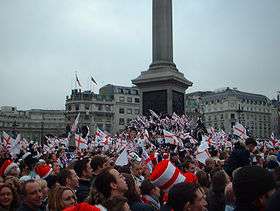
England, and other countries in the United Kingdom, compete as a separate nations in some international sporting events, especially in football, cricket, rugby league and rugby union. The England cricket team actually represents England and Wales.[163] However, in the Olympic Games, England competes as part of the Great Britain team. English supporters are now more likely to carry the Cross of Saint George flag than the British Union Flag.[164]
Football maintains a consistent popularity across the country and is often indicative of trends across wider culture in England, such as in clothing and music. Different sports directly represent the different social classes within England. Rugby league, for instance, was traditionally associated with the old mill towns of north-west England, whereas cricket and rugby union have their origins in the private schools of the 18th and 19th centuries respectively.
Symbols

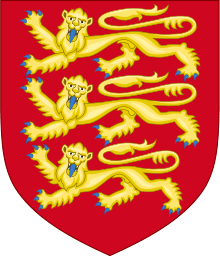
The English use as their national flag the red cross of St George. St George's Day in England is marked as the day of the patron saint, and is also celebrated as the day of birth and death of William Shakespeare.
In 1198, King Richard the Lionheart introduced the coat of arms of England, depicting "three lions".[165] The three lions form the basis of several emblems of English national sports teams, such as the England national football team,[166] and the English national cricket team (though in blue rather than gold). The English oak and the Tudor rose are also English symbols, the latter of which is (although more modernised) used by the England national rugby union team.
England has no official anthem; however, the United Kingdom's "God Save the Queen" is commonly used. Other songs are sometimes used, including "Land of Hope and Glory" (used as England's anthem in the Commonwealth Games), "Jerusalem", "Rule Britannia", and "I Vow to Thee, My Country". Moves by certain groups are encouraging adoption of an official English anthem following similar occurrences in Scotland and Wales.[167][168]
See also
References
- ↑ Little, Allan (2018-06-06). "Scotland and Britain 'cannot be mistaken for each other'". BBC News. Retrieved 2018-06-06.
- ↑ "How proud is your area of being English?". BBC News. 2018-06-03. Retrieved 2018-06-04 ; Easton, Mark (2018-06-03). "The English question: What is the nation's identity?". BBC News. Retrieved 2018-06-04.
- 1 2 3 "The expert selection: British seaside piers" (1 August 2014). Financial Times. 15 June 2015.
- ↑ Dobraszczyk, Paul (2014). Iron, Ornament and Architecture in Victorian Britain: Myth and Modernity, Excess and Enchantment. Ashgate Publishing. p. 143. ISBN 978-1-472-41898-2.
- ↑ "A very British affair - the fall and rise of the seaside pier". BBC News. 16 June 2015.
- ↑ "Piers". National Piers Society (2006). Archived from the original on 29 September 2008. Retrieved 24 February 2012.
- ↑ According to Elizabeth Einberg, "by the time he died in October 1764 he had left so indelible a mark on the history of British painting that the term 'Hogarthian' remains instantly comprehensible even today as a valid description of a wry, satirical perception of the human condition." See the exhibition catalog, Hogarth the Painter, London: Tate Gallery, 1997, p. 17.
- ↑ "Satire, sewers and statesmen: why James Gillray was king of the cartoon". The Guardian. 16 June 2015.
- ↑ 'Food In England: A complete guide to the food that makes us who we are' Dorothy Hartley (1954)
- ↑ Richard L. Greaves Society and Religion in Elizabethan England, ISBN 978-0-8166-1030-3 p. 474: here
- ↑ 75 years of Family Food, Defra
- ↑ "How to make the perfect full English breakfast". 30 June 2015. The Telegraph
- ↑ An English breakfast sausage generally contains about 70 per cent meat, bread rusk and seasonings: What makes a British sausage British?. The 1984 episode Party Games of the television comedy 'Yes, Minister' involved Jim Hacker resisting the abolition of the British sausage by the EEC. As a result of his heroic stand he became Prime Minister.
- ↑ White pudding, although more common in Scotland and Ireland, is traditional in certain parts of England.
- ↑ For example, one retailer offered a breakfast in 2018 comprising "three rashers of British bacon, three British pork sausages, three hash browns, two half slices of fried bread, two fried eggs, two half tomatoes, two black puddings, baked beans and sliced mushrooms." Big Daddy Breakfast. The English Breakfast Society researches, records and publishes the history, heritage and traditions of the English breakfast.
- ↑ 'Craster: inside Northumberland's centuries-old kipper smokehouse' The Telegraph (16 January 2016)
- ↑ 'Bubble and Squeak' British Food: A History
- ↑ Why do the French call the British 'the roast beefs'?
- ↑ Roast Beef and Yorkshire Pudding with Horseradish Relish AHDB Beef and Lamb division of the Agriculture and Horticulture Development Board
- ↑ 'The Sunday roast: a tradition worth preserving' The Guardian (5 March 2016)
- ↑ Spring-born English lamb fed on grass is actually at its best in the summer, from around mid-June to September). Over the last half century there has been a swing in preference amongst English consumers from mutton to lamb.
- ↑ Emett, Charlie (2003) "Walking the Wolds". Cicerone Press Limited, 1993
- ↑ Christmas customs and traditions
- ↑ Protected food name: London cure smoked salmon
- ↑ 'English cooking: A new approach' (1960) Rupert Croft-Cooke
- ↑ Many traditional recipes are described in the Be-Ro recipe book, first published in 1923 Be-Ro
- ↑ National Fish & Chip Day The National Edible Oil Distributors’ Association
- ↑ See offal
- ↑ Main meal dishes in England, Mandy Barrow Project Britain: Foods in Britain
- ↑ 'How Britain got the hots for curry' BBC News (26 November 2009)
- ↑ Butchers Guide to the British Banger The Great British Meat Co
- ↑ More Than A Bit On The Side AHDB Potatoes
- ↑ Consider the Dumpling The Guardian (26 October 2010)
- ↑ 'Praise the lard: Pork fat - and its gourmet cousin lardo - are having a revival' The Independent (13 December 2012)
- ↑ A raised pie (i.e. a free-standing pie that does not have the support of a pie tin) made with hot water crust pastry, particularly associated with the town of Melton Mowbray
- ↑ Essential Sandwiches and Picnic Foods England Traditional English Recipes
- ↑ Sandwiches Food Timeline FAQs
- ↑ Lea & Perrins website
- ↑ 'Classic British puddings ranked from worst to best' Metro (15 October 2015)
- ↑ Rhubarb is strictly a vegetable but is used for culinary purposes like a fruit.
- ↑ 'Ice-cream van chimes: the sound of the British summer' The Guardian (12 July 2013)
- ↑ Rodda's website
- ↑ Cucumber Tea Sandwiches All About Afternoon Tea
- ↑ The Queen and her Cakes English Heritage (5 August 2015)
- ↑ Simnel Cake All About Afternoon Tea
- ↑ https://www.theguardian.com/lifeandstyle/2009/nov/14/crumpets-muffins-pikelets-farls 'Hugh Fearnley-Whittingstall's tea-time treats'] The Guardian (14 November 2009)
- ↑ Pikelets vs crumpets. What's the difference? Village Bakery. It should be noted that Scottish-style crumpets differ from English crumpets How to make Scottish-style crumpets
- ↑ A form of rounded, yeast-leavened bread, also used as the base of eggs Benedict)
- ↑ "The British are so easy to please. It is the most extraordinary thing. They actually like their pleasures small. That is why, I suppose, so many of their treats — teacakes, scones, crumpets, rock cakes, rich tea biscuits, fruit shrewsburys — are so cautiously flavourful. They are the only people in the world who think of jam and currants as thrilling constituents of a pudding or cake." 'Notes From A Small Island' Bill Bryson (1995)
- ↑ 'Classic British cake' is the theme of the GBBO final: which is your favourite? The Telegraph (7 October 2015)
- ↑ Pancake Day Historic UK
- ↑ British Cheese Board
- ↑ Dr Penny Stanway (7 Nov 2013). The Miracle of Tea: Practical Tips for Health, Home and Beauty. Duncan Baird Publishers. p. 68.
- ↑ The Telegraph (5 August 2015)'Is Britain falling out of love with tea?' At the time of Jonathan Routh's 'Good Cuppa Guide: Where to have tea in London' (1966) tea was the most popular beverage.
- ↑ Rupert Millar (19 July 2018). "Beer and Cider Boom in the UK". thedrinksbusiness.com.
- ↑ A Beginner's Guide to British Beer Styles
- ↑ Why don't men drink mild ale any more? The Telegraph 15 May 2015
- ↑ South West of England Cidermakers’ Association (SWECA) website
- ↑ Magna Carta Anniversary
- ↑ The sale of alcohol in licensed premises
- ↑ Gin History, Development & Origin
- ↑ Pimm's website
- ↑ Promoting the Fine Wines of England Wines of Great Britain Limited (Wine GB), the official body for the UK Wine Industry
- ↑ Keary 1882, p. 50.
- ↑ Pollard 2004, p. 272.
- ↑ Michael Wood, "King Arthur, 'Once and Future King'", BBC, bbc.co.uk, retrieved 16 September 2009
- ↑ Higham, NJ (2002). King Arthur: myth-making and history. Routledge, 2002
- ↑ Briggs 2004, p. 26.
- ↑ Withington 2008, p. 224.
- ↑ "What is England's national costume?". Woodlands-Junior.kent.sch.uk. Archived from the original on 5 May 2009. Retrieved 24 June 2009.
- 1 2 A general history of the robberies & murders of the most notorious pirates. Charles Johnson. Introduction and commentary to A General History of the Pyrates by David Cordingly. p. viii. Conway Maritime Press (2002).
- ↑ Angus Konstam (2008) Piracy: The Complete History p.313. Osprey Publishing, Retrieved 11 October 2011
- ↑ Dan Parry (2006). "Blackbeard: The Real Pirate of the Caribbean". p. 174. National Maritime Museum
- ↑ Bonanos, Christopher. "Did pirates really say "arrrr"? – By Christopher Bonanos – Slate Magazine". Slate.com. Retrieved 18 December 2008.
- ↑ Defoe, Daniel (1726). The four years voyages of capt. George Roberts. Written by himself. p. 89.
- ↑ Botting, p. 48, Konstam, The History of Pirates, p. 98
- ↑ Graeme Donald Sticklers, Sideburns & Bikinis: The Military Origins of Everyday Words and Phrases p.147. Osprey Publishing, 2008
- ↑ Aftermath: Commemoration, gunpowderplot.parliament.uk, 2005–2006, archived from the original on 8 April 2009, retrieved 21 January 2010
- ↑ "V for Vendetta masks: Who's behind them?". BBC News. Retrieved 1 April 2013
- ↑ Wolfgang Vierick (1964), Der English Dialect Survey und der Linguistic Survey of Scotland - Arbeitsmethoden und bisherige Ergebnisse, Zeitschrift für Mundartforschung 31, 333-335 in Shorrocks, Graham (1999). A Grammar of the Dialect of the Bolton Area, Part 1. Frankfurt am Main: Peter Lang. p. 58. ISBN 3-631-33066-9.
- ↑ Paediatric-Epidemiology Significance Surnames Paper; University College London
- ↑ Jurisdiction Of Courts In England And Wales And Their Recognition Of Foreign Insolvency Proceedings Archived 9 June 2008 at the Wayback Machine.
- ↑ Archived 28 September 2008 at the Wayback Machine.
- ↑ "Sir William Blackstone". Britannica. Retrieved 29 April 2015.
- ↑ Moore, Christopher (1997). The Law Society of Upper Canada and Ontario's lawyers, 1797–1997. University of Toronto Press. ISBN 0-8020-4127-2.
- ↑ Anthony Wright (1994). "Citizens and subjects: an essay on British politics". Routledge, 1994
- ↑ A V Dicey (1897). "Introduction to the Study of the Law of the Constitution".
- ↑ "Still the Moon Under Water". The Economist. London. 28 July 2009.
- ↑ "How to make a perfect cuppa: put milk in first". The Guardian. Retrieved 30 December 2014
- ↑ BBC – The Big Read – Top 100 Books. Retrieved 2010-27-11.
- ↑ "With tears and songs, London pays homage to 'starman in the sky' David Bowie". Sydney Morning Herald. 14 January 2016.
- ↑ The BBC Proms, what's it all about?
- ↑ "The top 21 British directors of all time". The Daily Telegraph
- ↑ "Hitchcock: he always did give us knightmares". Roger Ebert.com. 2 January 1980.
- ↑ "The Directors' Top Ten Directors". British Film Institute. Archived from the original on 27 May 2012.
- ↑ St. Pierre, Paul Matthew (1 April 2009). Music Hall Mimesis in British Film, 1895–1960: On the Halls on the Screen. New Jersey: Fairleigh Dickinson University Press. p. 79. ISBN 978-1611473995.
- ↑ "Harry Potter becomes highest-grossing film franchise". The Guardian. London. 11 September 2007. Retrieved 2 November 2010.
- ↑ "History of Ealing Studios". Ealing Studios. Archived from the original on 26 July 2013. Retrieved 9 March 2015.
- ↑ London Symphony Orchestra and Film Music Archived 30 September 2011 at the Wayback Machine. LSO. Retrieved 30 June 2011
- ↑ "Life of Brian tops comedy poll". BBC News (Total Film magazine poll: 29 September 2000) Retrieved 27 June 2015
- ↑ "Jets, jeans and Hovis". The Guardian. 12 June 2015.
- ↑ Statistical Yearbook 2011: 7.3 UK directors Archived 15 June 2012 at the Wayback Machine.. UK Film Council.
- ↑ "Does Andy Serkis's motion capture acting deserve an Oscar?". The Telegraph. Retrieves 11 January 2015
- ↑ "Tim Webber: the man who put Sandra Bullock in space". London Evening Standard. Retrieved 17 January 2014
- ↑ Barry Ronge's Classic DVD : Alice in Wonderland, The Times, It was made under the personal supervision of Walt Disney, and he took special care when animating British fantasy. He called them his "English Cycle".
- ↑ Matthew Collin, John Godfrey (2010). "Altered State: The Story of Ecstasy Culture and Acid House" p.258. Retrieved 18 February 2012
- 1 2 Foreman, Susan (2005). London: a musical gazetteer. Yale University Press
- 1 2 "Punch and Judy around the world". The Daily Telegraph. 11 June 2015.
- ↑ "Mr Punch celebrates 350 years of puppet anarchy". BBC. 11 June 2015.
- 1 2 3 "The circus comes to the Circus". BBC News. Retrieved 13 December 2014
- ↑ Great dynasties of the world: The Chipperfields The Guardian Retrieved 18 February 2011.
- ↑ Hamilton, John (2000) Entertainment: A Pictorial History of the Past One Thousand Years p.24. Retrieved 3 February 2011.
- ↑ Explore PA history.com – Historical Markers
- ↑ 'Popular Entertainments through the Ages', Samuel McKechnie. London; Sampson Low, Marston & Co Ltd., 1931
- ↑ "20 Years of Laughter] p.14. Turner Publishing Company, 2006
- 1 2 3 David Christopher (2002). "British Culture: An Introduction". p. 74. Routledge,
- ↑ "It's behind you: To understand the British—and have fun—go and see a Christmas pantomime". The Economist. Retrieved 2 January 2015
- ↑ "Enjoy Cumbria - Stan Laurel". BBC. Retrieved 2 January 2015
- ↑ "English Heritage - Gracie Fields". English Heritage. Retrieved 2 January 2015
- ↑ McCabe, John. "Comedy World of Stan Laurel". p. 143. London: Robson Books, 2005, First edition 1975
- ↑ J. P. Gallagher (1971). "Fred Karno: master of mirth and tears". p. 165. Hale.
- ↑ See Central Council of Church Bell Ringers website
- ↑ The Rusty Dagger Awards 1996 - The Best British Crime Novel of the 1930s
- 1 2 Durston, Chris, "Lords of Misrule: The Puritan War on Christmas 1642–60", History Today, December 1985, 35 (12) pp. 7 – 14. Archived at the Internet Archive
- ↑ Old, Hughes Oliphant (2002). Worship: Reformed According to Scripture. Westminster John Knox Press. p. 29. ISBN 9780664225797.
- ↑ Carl Philipp Emanuel Nothaft (October 2011). "From Sukkot to Saturnalia: The Attack on Christmas in Sixteenth-Century Chronological Scholarship". Journal of the History of Ideas. University of Pennsylvania Press. 72 (4): 504–505. JSTOR 41337151.
However, when Thomas Mocket, rector of Gilston in Hertfordshire, decried such vices in a pamphlet to justify the parliamentary 'ban' of Christmas, effective since June 1647...
- ↑ Sandys, William (1852). Christmastide: its history, festivities and carols. London: John Russell Smith. pp. 119–120.
- ↑ Miall, Anthony & Peter (1978). The Victorian Christmas Book. Dent. p. 7. ISBN 0-460-12039-5.
- ↑ Les Standiford. The Man Who Invented Christmas: How Charles Dickens's A Christmas Carol Rescued His Career and Revived Our Holiday Spirits, Crown, 2008. ISBN 978-0-307-40578-4
- 1 2 Joe L. Wheeler. Christmas in my heart, Volume 10. p.97. Review and Herald Pub Assoc, 2001. ISBN 0-8280-1622-4
- ↑ Ronald Hutton Stations of the Sun: The Ritual Year in England. 1996. Oxford: Oxford University Press. ISBN 0-19-285448-8.
- ↑ Richard Michael Kelly (ed.) (2003), A Christmas Carol. pp.9,12 Broadview Literary Texts, New York: Broadview Press ISBN 1-55111-476-3
- ↑ Robertson Cochrane. Wordplay: origins, meanings, and usage of the English language. p.126. University of Toronto Press, 1996 ISBN 0-8020-7752-8
- ↑ Earnshaw, Iris (November 2003). "The History of Christmas Cards". Inverloch Historical Society Inc. Retrieved 25 July 2008.
- 1 2 3 "Blue Plaques". English Heritage. Retrieved 16 June 2011.
- ↑ Kelly, Jon (21 December 2011). "Will British people ever think in metric?". BBC. Retrieved 4 May 2015.
- ↑ Christine Hopkins, Ann Pope, Sandy Pepperell (2013). "Understanding Primary Mathematics". p. 195. Routledge.
- ↑ J. Gascoin, "A reappraisal of the role of the universities in the Scientific Revolution", in David C. Lindberg and Robert S. Westman, eds, Reappraisals of the Scientific Revolution (Cambridge: Cambridge University Press, 1990), ISBN 0-521-34804-8, p. 248.
- ↑ Kiely, Ray (November 2011). "Industrialization and Development: A Comparative Analysis". UGL Press Limited: 25–26.
- 1 2 "Why the Industrial Revolution Happened Here". BBC. 11 January 2017.
- ↑ "They Broke It". New York Times. 9 January 2009.
- 1 2 3 4 5 6 7 Burns Windsor, D (1980). The Quaker Enterprise: Friends in Business. London: Frederick Muller Ltd. ISBN 0-584-10257-7.
- ↑ Ronald Shillingford (2010). "The History of the World's Greatest- Entrepreneurs: Biographies of Success". p.64-69
- ↑ Kirby, Maurice W. (4 July 2002). The Origins of Railway Enterprise: The Stockton and Darlington Railway 1821–1863. Cambridge University Press. ISBN 978-0-521-89280-3.
- ↑ "Oyster card celebrates 150th Tube anniversary". BBC News. 10 December 2012. Retrieved 5 April 2016.
- ↑ "Henry Maudsley Facts". Yourdictionary.com. 22 May 2016.
- ↑ Quentin R. Skrabec, Jr. (2005). "The Metallurgic Age: The Victorian Flowering of Invention and Industrial Science". p. 169. McFarland
- ↑ Wilson, Arthur (1994). The Living Rock: The Story of Metals Since Earliest Times and Their Impact on Civilization. p. 203. Woodhead Publishing.
- ↑ Rudd, Alyson (7 April 2008). "The father of football deserves much more". London: Times Online. Retrieved 15 January 2015.
- ↑ "Pelé joins Sheffield celebrations". BBC. 25 June 2015.
- ↑ Paul Mitchell. "The first international football match". BBC. Retrieved 15 January 2015.
- ↑ "Hurst the hero for England in the home of football". FIFA.com.
- ↑ "Tracking 30 years of TV's most watched programmes". BBC. Retrieved 20 January 2015
- ↑ "History and time are key to power of football, says Premier League chief". The Times. Retrieved 30 November 2013
- 1 2 "Sport's greatest-ever upset". Sporting Life. 2 May 2016. Archived from the original on 3 May 2016. Retrieved 3 May 2016.
- ↑ Caudwell, J.C. (2011). "'Does your boyfriend know you're here?' The spatiality of homophobia in men's football culture in the UK". Leisure Studies. 30 (2): 123–138.
- ↑ Richard Holt, Tony Mason. Sport in Britain, 1945–2000. p.129. Wiley-Blackwell, 2000
- 1 2 125 years of Wimbledon: From birth of lawn tennis to modern marvels CNN. Retrieved 28 September 2011
- ↑ Tyzack, Anna, The True Home of Tennis Country Life, 22 June 2005
- ↑ History of Tennis International Tennis Federation. Retrieved 28 July 2008.
- ↑ Major Walter Clopton Wingfield Archived 6 September 2011 at the Wayback Machine. International Tennis Hall of Fame. Retrieved 28 September 2011
- ↑ "Wimbledon's strawberries and cream has Tudor roots". BBC. 9 June 2015.
- ↑ "England Cricket Team Profile". Archived from the original on 9 December 2006. Retrieved 13 September 2006.
- ↑ "The Saturday Soap Box: We have to make Jerusalem England's national anthem". Daily Mirror. 17 September 2005. Archived from the original on 11 October 2006. Retrieved 1 November 2006.
- ↑ Woodcock, T. & Robinson, J.M. (1988). The Oxford Guide to Heraldry
- ↑ Ingle, Sean (18 July 2002). "Why do England have three lions on their shirts?". The Guardian. Retrieved 29 April 2016.
- ↑ Anthem 4 England - English National Anthem
- ↑ Anthem for England
Further reading
- Briggs, Asa (1994) A Social History of England: from the ice age to the channel tunnel; new ed. London: Weidenfeld & Nicolson ISBN 029783262X (1st ed. 1983)
- Redlich, Monica (1957) Everyday England. London: Gerald Duckworth
.jpg)
